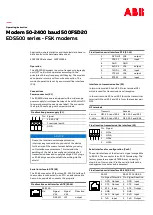
- 23 -
TC2100 DM
User's Manual
Ver. 1.6
MNL-21000-01-16
Commonly Asked Questions
1. How do I begin to install a counter-rotating ring configuration ?
Ans:
Begin with the A-Ring on the Master unit, then expand with Slaves one at a time in a clockwise direction.
Every time a Slave is added, check the ring's integrity. The Master's "LPA" and "LPB" LEDs are designed for
this purpose. Always finish the A-Ring connections first and then connect the B-Ring in the same fashion,
only counterclockwise. Keep in mind that the "TxA" optic always connects to the downstream unit's "RxA"
receptacle in the A-Ring, and "TxB" always connects to "RxB" in the opposite direction on the B-Ring.
2. How do I know if the optic ring is closed or if the fiber cables are cross-connected somewhere in the ring ?
Ans:
The "LPA" and/or "LPB" LEDs on the Master unit will flash if the associated ring is not closed. If the "RxA"
cable is mixed up with the "RxB" cable, the A-Ring and B-Ring are considered "open" and the appropriate
LEDs will flash.
3. What direction is the optic signal traveling in ?
Ans:
The optic signal traveling clockwise is designated as the "A-Ring," which means the fiber connections from
one unit's optic "TxA" to the next unit's "RxA," until the ring is complete. Always install the A-Ring first and
verify it's integrity before starting the B-Ring.
The fiber optic signal traveling counterclockwise is designated as the "B-Ring," which means the fiber
connections from one unit's optic "TxB" to the next unit's "RxB," until the ring is complete.
4. What do the front panel's "BRD" & "RSP" LEDs mean ?
Ans:
The "BRD-1" & "BRD-2" stand for Broadcast Data. They are the signals from the SCADA Host (connected
to the Master) to be transmitted (or broadcasted) to the Slaves. The "BRD-1" & "BRD-2" LEDs on the Master
unit reflect the incoming signal status of the DB25's connector pins 2 & 4 (for an RS-232 interace) from the
SCADA host. On the Slave units, the "BRD-1" & "BRD-2" are the received broadcast signals originating from
the SCADA host.
The "RSP-1" & "RSP-2" stand for Response Data. On the Slave unit, they are the response signals from the
local RTU to be transmitted to the Master. The "RSP-1" & "RSP-2" LEDs on the Slave unit reflect the outgoing
signal status of the DB25's connector pins 3 & 5 (for an RS-232 interface) from the local RTU. On the Master,
the "RSP-1" & "RSP-2" are the received response signals originating from the RTU.
5. What is the built-in signal generator and how is it used ?
Ans:
For the TC2100 (Master), by sliding the SIG GEN (ESW3) DIP switch to the down (On) position, a pulse
signal will be generated to simulate an incoming signal on the DB25's connector pins. In effect, this pulse
signal is a simulated broadcast signal from the SCADA host, which will travel through the fiber to each Slave
in the ring. This function is very useful for troubleshooting and verifying network integrity. The slow pulse
rate of these LEDs can be easily confirmed at any Slave location.
For the TC2100 (Slave), by sliding the SIG GEN (ESW3) DIP switch to the down (On) position, a pulse signal
will be generated to simulate an incoming signal on the DB25’s connector pins just like TC2100 (master).
However, this pulse signal is a simulated response signal from the RTU, which will travel through the fiber to
Master in the ring. This function is very useful for troubleshooting and verifying network integrity. The slow
pulse rate of these LEDs can be easily confirmed at Master location.
6. What is the "Sync-A" LED ?
Ans:
The "Sync-A" LED turns "On" (solid) once synchronization has been established and remains "On" (solid)
so long as sync is maintained. This LED should only flash when the optic signal has been disrupted. The same
applies to the "RxB" and "Sync-B" LEDs for the B-Ring.
7. Where is the best location for “Dual Master” unit?
Ans:
Anywhere. It all depends on customer’s application and equipments.




































